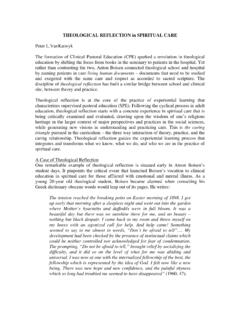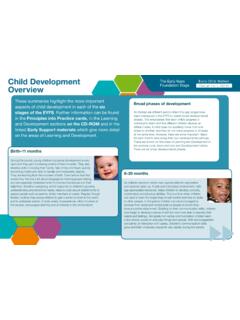Transcription of FAMILY LIFE CYCLE THEORY
1 FAMILY LIFE CYCLE THEORY This educational CAPPE module i is part ii in section IV: Theories of Human development Written by Peter L. VanKatwyk, A FAMILY Story Mrs. Berg came to see her pastor in a state of depression. She located the onset of her distress in her daughter s recent departure from home to stay with a favorite aunt and her FAMILY some 500 kilometers away. The move was intended as a time-out strategy in countering a run-away escalation of FAMILY stress at home. Mrs. Berg had been the main impetus in getting her 16-year-old daughter out of the house something that now flooded her with feelings of guilt and regret.
2 The mother-daughter relationship had been severely conflicted for at least the last two years. A recurring memory of an especially ugly fight on the eve of her daughter s departure, had become an obsession in the mother s mind. In sharp contrast, her husband could look back on a largely pleasant, often playful, relationship with his daughter. The mother was left isolated and resentful in losing a daughter from whom she felt now separated not only relationally but also geographically. She was grieving a double loss, both stemming from her sense of failure as a parent.
3 Questions: What ways can you think of in which a spiritual care-provider could conceptualize this crisis situation? What possible helping-strategies come to mind? Whom would you prefer to work with: o individually with Mrs. Berg, Mr. Berg, or the daughter? o systemically with the FAMILY or the couple? The Time Perspective. Families are shaped by people who share a history and a future together. From this time perspective families are living systems moving through time. With the contemporary FAMILY pulsing with plural, multicultural patterns there is not one set course or normative sequence by which families develop over time.
4 Monica McGoldrick and Betty Carter in their respected work on the FAMILY life CYCLE describe its underlying processes to be negotiated by the expansion, contraction, and realignment of the relationship system to support the entry, exit, and development of FAMILY members in a functional way (2003, 384). Major life- CYCLE transitions are marked by fundamental changes in the FAMILY system itself (second order changes) rather than rearrangements within the system (first order changes). McGoldrick and Carter have designed a classification of critical, fundamental FAMILY life- CYCLE stages of American middle-class families in the beginning of the 21st century (1999, 2).
5 1 Their classification table lists six stages of the FAMILY life CYCLE : 1. Leaving home: single young adults 2. The joining of families through marriage: the new couple 3. Families with young children 4. Families with adolescents 5. Launching children and moving on 6. Families in later life Each of these life CYCLE stages is correlated with two major dimensions: 1. Emotional Process of Transition: Key Principles. 2. Second-Order Changes in FAMILY Status Required to Proceed Developmentally. Case Illustration #1 According to the above chart the Berg FAMILY is in stage 4. The adolescent daughter triggers the life CYCLE transition that throws the FAMILY system out of balance.
6 Following the chart, stage 4 describes the emotional process of transition as follows: Increasing flexibility of FAMILY boundaries to permit children s independence and grandparents frailties. This stage involves the following second-order changes in FAMILY status: Shifting of parent/child relationships to permit adolescents to move into and out of system Refocus on midlife marital and career issues Beginning shift toward caring for older generation. Questions from a FAMILY life CYCLE perspective on the Berg FAMILY : what do you see as primarily responsible for causing the problem?
7 Who is best positioned for addressing and solving the problem? where to start with the problem or with the solution? The time perspective relates problems to the flow of stress through the FAMILY and how it is addressed in the process of FAMILY coping. Therapists have long noted that presenting problems often coincide with critical transition points in the FAMILY life CYCLE (Haley, 1973). Problems can take on a life of their own, reified as distinct entities, rather than being the signals that punctuate critical moments in the life CYCLE . For families and couples such awareness helps in normalizing their crisis experience of what may appear catastrophic.
8 Carter and McGoldrick observe: Families characteristically lack time perspective when they are having problems. They tend generally to magnify the present moment, overwhelmed and immobilized by their immediate feelings; or they become fixed on a moment in the future that they dread or long for. They lose the awareness that life means continual motion from the past into the future with a continual transformation of familial relationships (1999, 4). 2 Life CYCLE transitions shift the state of FAMILY relationships and require a repositioning in the relational dynamics. This is the emotional process (Kerr & Bowen, 1988) by which the FAMILY regulates the balance between individuality and togetherness, the dance between contraction and expansion in the evolution of FAMILY relationships.
9 The Genogram as Assessment Instrument The genogram is a popular and useful instrument as a graphic representation of the FAMILY as an emotional system moving through space and time over at least three generations (McGoldrick & Gerson, 1985; Carter & McGoldrick, 1999). The genogram maps recurring behavioral patterns and emotional ties between FAMILY members. The genogram has become a standard assessment tool for a systemic approach in therapy and is generally shared with the FAMILY . Presenting problems lose their narrow focus on the individual when they begin to tell the story of the FAMILY .
10 The genogram differentiates between the various roles by which each person participates in the FAMILY system. Edwin Friedman in Generation to Generation (1985, 32-34) shows examples of how multigenerational transmission can be charted on genograms to help FAMILY members gain more distance from their immediate lives and concerns. Case Illustration #2 According to the genogram in Figure 1, Mrs. Berg is the oldest of five children in her FAMILY of origin. Not only being the first born, but also the untimely death of the second child, distanced Mrs. Berg from her younger siblings and accentuated her care-taking role as the parental child in the FAMILY .






